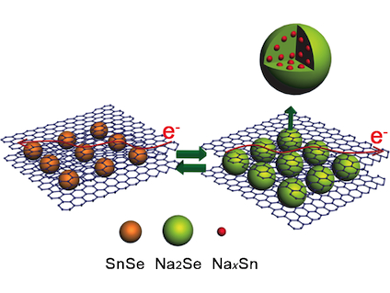Sodium ion batteries (SIBs) have recently attracted renewed attention for their potential as a low-cost means of energy storage. Although sodium can reversibly alloy with other metals with high theoretical capacities (Ge, Sn, Sb), in particular tin-based compounds SnM (where M = P, S, Se), these compounds undergo rapid capacity degradation, necessitating the use of nanocomposites with carbonaceous materials, such as carbon black and carbon nanofibers. Graphene has been extensively applied in electronics, bioengineering, and energy storage, owing to its high tensile strength and Young’s modulus.
Fei Du and co-workers at Jilin University, China, have developed a nanocomposite of SnSe with reduced graphene oxide (RGO) that is synthesized through a facile ball-milling method. The SnSe/RGO nanocomposite exhibits a high specific capacity (590 mA h g–1 at 0.05 A g–1) and rate capability (260 mA h g–1 at 10 A g–1), and excellent cycle stability (98 % capacity retention over 120 cycles at 1 A g–1) in comparison to SnSe, rendering it a promising potential anode material for SIBs.
- Assembly of SnSe Nanoparticles Confined in Graphene for Enhanced Sodium-Ion Storage Performance,
Xu Yang, Rongyu Zhang, Nan Chen, Xing Meng, Peilei Yang, Chunzhong Wang, Yaoqing Zhang, Yingjin Wei, Gang Chen, Fei Du,
Chemi. Europ. J. 2015.
DOI: 10.1002/chem.201504074



